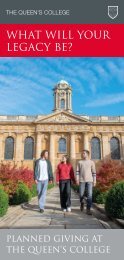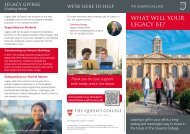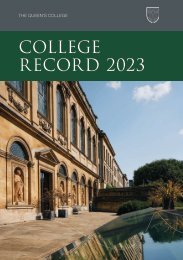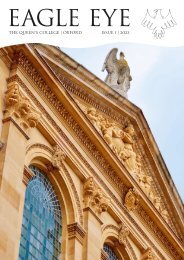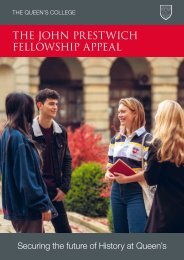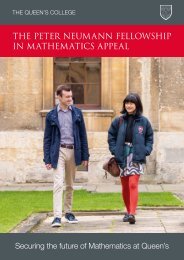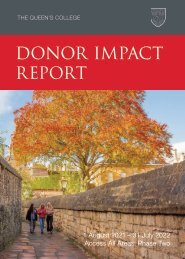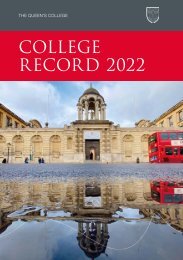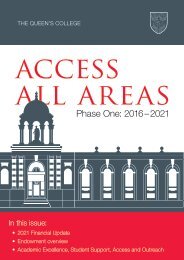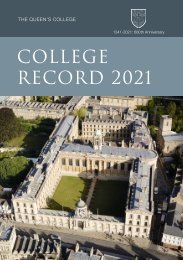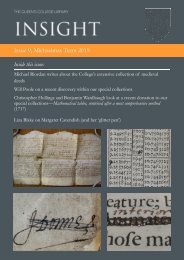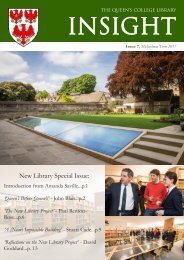Insight 2018
Create successful ePaper yourself
Turn your PDF publications into a flip-book with our unique Google optimized e-Paper software.
THE QUEEN’S COLLEGE LIBRARY<br />
Issue 8 Michaelmas Term <strong>2018</strong><br />
Inside this issue:<br />
New Light on a Forgotten Astronomer—Will Poole<br />
David Constantine on Modern Poetry in Translation<br />
Archibald H. Sayce and his Papers at The Queen’s College, Oxford
W<br />
elcome to Issue 8 of <strong>Insight</strong>. After the<br />
new building special of last year we<br />
have reverted to our normal format of<br />
articles associated with the Library’s collections.<br />
The first article is by Will Poole of New College who<br />
last wrote a piece for <strong>Insight</strong> five years ago. Will, a<br />
regular reader of our special collections, has recently<br />
been to Queen’s Library several times to consult a<br />
series of tiny seventeenth century mathematical<br />
notebooks by Richard Rawlinson, student and<br />
Fellow of Queen’s during the turbulent years of the<br />
Civil War and the Cromwellian Protectorate. Will’s<br />
article casts<br />
light on this<br />
fascinating<br />
and little<br />
known<br />
astronomer<br />
of the<br />
seventeenth<br />
century<br />
scientific<br />
revolution.<br />
One of<br />
Rawlinson’s<br />
exquisite<br />
manuscripts<br />
Rawlinson Mathematical Notebook, circa 1646.<br />
(Queen’s MS346)<br />
(pictured) has recently featured as our “book of the<br />
month” in the New Library.<br />
Earlier this year, our thematic exhibition installed in<br />
both the Upper Library and the New Library was<br />
entitled Opening the Frontiers: Modern Poetry in<br />
Translation in the Sixties and Since. It was co-curated by<br />
David Constantine, who has expanded on the<br />
associated talk he and co-curators gave at the launch<br />
of the exhibition to write about the lasting political<br />
and cultural importance of translating and<br />
disseminating poetry around the globe. The article<br />
and the exhibition celebrate the fact that Queen’s<br />
Library has recently received a substantial run of the<br />
journal Modern Poetry in Translation which David and<br />
Helen Constantine co-edited from 2003-12.<br />
L-R: Helen Constantine, David Constantine and Clare Pollard pictured<br />
in discussion at our exhibition event.<br />
Our final substantive article is by Silvia Alaura and<br />
Marco Bonechi from the Consiglio Nazionale delle<br />
Ricerche (CNR) in Rome. Marco and Silvia spent<br />
several weeks last December investigating the Sayce<br />
Papers kept in the College Library, and have written<br />
a wide-ranging account of the life and career of one<br />
of the fascinating late nineteenth/early twentieth<br />
century personalities of Queen’s, for whom the<br />
University created a Chair of Assyriology in 1891.<br />
The final pages of this issue highlight the current<br />
library exhibition curated by recent graduate Sarah<br />
Gouldesbrough, which is based on her DPhil<br />
subject and is entitled Images of Epic: Representations of<br />
Homer and his Works from the Archive to the Comic Book.<br />
I am very grateful to all the contributors who wrote<br />
for this year’s issue and to my colleague, Sarah Arkle,<br />
who took many of the photographs and undertook<br />
the typesetting. I would also like to express my<br />
gratitude to the college’s Director of<br />
Communications, Emily Downing, for the new<br />
design.<br />
If you have ideas for future articles or indeed<br />
would like to contribute, please contact me<br />
E-mail: amanda.saville@queens.ox.ac.uk<br />
Tel: 01865 279213<br />
Amanda Saville, Librarian, October <strong>2018</strong><br />
2
O<br />
n 12 August 1654, in one of the<br />
opening conflicts of the Russo-Polish<br />
War of 1654–1667, a Polish-Lithuanian army<br />
conquered a numerically superior Russian force in<br />
the Battle of Skhlow. Just as the Russians began to<br />
cross the Dnieper river, the Polish surprised them,<br />
driving them back into the water. In seizing the<br />
element of surprise, the combined Polish forces were<br />
assisted by an unlikely ally—a solar eclipse.<br />
setting, three dons had gathered to observe the<br />
eclipse. They were the Savilian Professor of<br />
Geometry, John Wallis, and two younger dons ‘most<br />
expert in mathematical matters’, Christopher Wren<br />
of All Souls, and Richard Rawlinson of Queen’s. The<br />
three men set up a telescope to project the image of<br />
the sun onto a piece of paper, so that the progress of<br />
the eclipse could be marked at regular intervals on<br />
the paper. Rawlinson later engraved onto a brass<br />
plate the observations they had made, and the image<br />
was published as part of Wallis’s later account of the<br />
eclipse. Wallis was not a natural acknowledger of<br />
assistance, but Rawlinson memorialized his own role<br />
by signing his engraving: ‘Ri: Rawlinson cælavit’,<br />
‘Richard Rawlinson engraved this’.<br />
The names of Christopher Wren and John Wallis<br />
remain well known, but who was this forgotten<br />
astronomer of Queen’s?<br />
Richard Rawlinson was born, probably in 1618, in<br />
Milnthorpe, Westmorland, one of the college’s<br />
traditional recruiting territories, and entered Queen’s<br />
in 1636 as an eighteen year-old of plebeian rank. It is<br />
very likely he was the first member of his family to<br />
attend university. In 1640 he was elected a Taberdar,<br />
and the next year he took his BA. Life in Oxford was<br />
soon to be turned upside-down, however, with the<br />
outbreak of civil war, and in late 1642 the king and<br />
his troops were forced to retreat to Oxford, which<br />
became for the next three and a half years the<br />
headquarters of the royalist campaign. This is when<br />
we hear our first distinctive news about Rawlinson,<br />
who had evidently been reading books on<br />
fortification, which he then put to good use. As the<br />
Oxford antiquary Anthony Wood recalled,<br />
Plate from Wallis’ Opera Mathematica in Queen’s College Upper Library,<br />
depicting the solar eclipse observed by Rawlinson in 1654. (40b.B.3)<br />
The Poles reckoned by the Gregorian calendar, but<br />
in Oxford, still on the Julian calendar, that same day<br />
was 2 August 1654. There, in a more peaceful<br />
The Works and Fortifications also did now go on<br />
apace, and those in St Clement’s Parish, on the East<br />
side of Oxford, were about this time begun. Which,<br />
with other Fortifications about the City, were mostly<br />
contrived by one Richard Rallingson, Bach. of Arts of<br />
Queen’s College, who also had drawn a Mathematical<br />
Scheme or Plot of the Garrison. (History and<br />
Antiquities, vol. 2, p. 462)<br />
3
Rawlinson (he is frequently encountered as<br />
‘Rallingson’) successfully managed to attract royal<br />
attention, and in recompense for his work Charles I<br />
ordered that he be created MA at once, a degree duly<br />
conferred upon Rawlinson by Convocation.<br />
Rawlinson was soon made a full fellow of the<br />
college, and at about this time he ought to have<br />
taken holy orders too. He dragged his feet, however,<br />
seemingly out of nervousness about the future<br />
direction of the Anglican Church, facing defeat, and<br />
by the time he was fully ordained, albeit in secret,<br />
Royalist Oxford was indeed on the brink of<br />
surrender to the Parliamentary forces. When the<br />
town fell, Rawlinson was prudently granted leave by<br />
the governing body of Queen’s to absent himself for<br />
one year, or even longer ‘should it prove necessary’.<br />
Indeed, when the Parliamentary Visitors came<br />
soberly to the doors of<br />
the college, Rawlinson<br />
could not be found.<br />
The Provost of<br />
Queen’s, Gerard<br />
Langbaine, described<br />
him as ‘a very excellent<br />
yong man, extremely<br />
studious, a general<br />
Scholar; but a most<br />
eminent<br />
Mathematicien’—but in<br />
the same letter to the<br />
authorities Langbaine<br />
was making feeble<br />
excuses for Rawlinson’s<br />
nonappearance,<br />
blaming it on<br />
aristocratic<br />
intervention. What<br />
seems to have<br />
happened is that<br />
Rawlinson was whisked<br />
off as a private tutor to<br />
Henry Pierrepont,<br />
Marquess of<br />
Dorchester, a safe way<br />
4<br />
of getting a promising young man with undeniable<br />
royalist sympathies out of town at a difficult time.<br />
Rawlinson did not stay away for too long, however:<br />
we find notices of him in the college records<br />
throughout the 1640s and 1650s, serving variously as<br />
a tutor, as one of the two annual treasurers, and as<br />
‘Magister puerorum’, or the choristers’ schoolmaster.<br />
The college accounts show that he drew his fellow’s<br />
stipend of £4 per annum every year until 1665/6,<br />
without exception. Rawlinson, in other words, was<br />
one of those royalist dons who found a way of living<br />
under an unpalatable Parliamentary regime by<br />
keeping out of the sight, and largely out of the mind,<br />
of the new authorities. In this way, the man who was<br />
said to have designed the royalist defences of Oxford<br />
(pictured below) was never formally ejected from his<br />
fellowship.<br />
Iconographia Oxoniae, showing Oxford’s defences, from Wood’s Historia et antiquitates Vniversitatis Oxoniensis<br />
(Queen’s Upper Library 52.f.13)
In the interregnum Queen’s specialized in this kind<br />
of temporizing. While Rawlinson was discreetly<br />
clinging to his fellowship, the college became a home<br />
for many young men of royalist cloth, for instance<br />
the well-to-do pair Robert Southwell and Joseph<br />
Williamson, both students in the 1650s, both future<br />
knights, and both future Presidents of the Royal<br />
Society of London. (Southwell’s student poetical<br />
notebook survives in the Bodleian, and offers a<br />
fascinating glimpse of Queen’s literary life in this<br />
decade.) Occasionally royalist sympathy lost its<br />
restraint: in 1657, for instance, one of Rawlinson’s<br />
own pupils, Lancelot Addison—we will encounter<br />
him again—delivered a supposedly comic oration in<br />
the university so inflammatory against the puritans<br />
that he was forced to recant in Convocation upon<br />
his knees. But in general Rawlinson’s milieu<br />
cultivated tact, and scholarly energies were directed<br />
to pursuits that were, or at least seemed, politically<br />
neutral.<br />
And so in the 1640s and ’50s Rawlinson devoted<br />
himself to mathematics, principally to geometry. We<br />
know this because an extensive set of little<br />
manuscripts, all in his hand, survive in Queen’s<br />
College Library. These eight pocket volumes work<br />
systematically through Euclid’s Elements and<br />
Theodosius’s Spherics, and are so carefully compiled<br />
and presented that they most probably functioned<br />
too as Rawlinson’s own textbooks for his pupils, or<br />
at least for his more mathematically inclined charges.<br />
He may have intended them for the press. Rawlinson<br />
also busied himself with the experimental philosophy<br />
clubs springing up in Oxford around this time, and<br />
in the 1650s he became acquainted with the<br />
intelligencer Samuel Hartlib and the scholar John<br />
Selden in London, as we learn from surviving letters<br />
sent by Gerard Langbaine to Selden, and from letters<br />
addressed to Hartlib by Rawlinson himself.<br />
Langbaine enlisted Rawlinson to copy out ancient<br />
Greek musical manuscripts in Oxford for Selden,<br />
who was assisting a continental editor of the ancient<br />
musical theorists. When in 1652 London’s Gresham<br />
Professor of Astronomy, Samuel Foster, died,<br />
Langbaine put in a good word with Selden for<br />
Rawlinson as a potential successor, hoping that the<br />
universally respected Selden might amplify this praise<br />
in the right ears. The great physician, inventor, and<br />
statistician William Petty, whom Rawlinson must<br />
have got to know at Oxford, also wrote in support<br />
of Rawlinson’s candidacy, noting in Rawlinson’s<br />
favour the ‘Bookes of his Owne compiling &<br />
Instruments of his owne hands making’. In the event<br />
the far superior Lawrence Rooke of Wadham got the<br />
job.<br />
An example of one of Rawlinson’s little geometry notebooks in the Special<br />
Collections at Queen's College Library. (Queen’s MS427)<br />
Petty referred to Rawlinson as a maker of scientific<br />
instruments. None of these has been recovered, but<br />
we can be sure that Rawlinson knew how to handle<br />
brass and burin, because, as we saw, he engraved his<br />
own plates. His correspondence with Hartlib shows<br />
that he engraved not only eclipse plates but also a<br />
more extended work he called his ‘short<br />
Trigonometry’. This turns out to have survived,<br />
albeit seemingly in a sole printed copy. It was<br />
probably engraved by Rawlinson in or just before<br />
1656, as he sent it to Hartlib in a letter of that year,<br />
along with the request to send further enclosed<br />
copies to the Dutch mathematician Frans van<br />
Schooten, and the French and Polish astronomers<br />
Ismaël Boulliau and Johannes Hevelius. We do not<br />
know if Hartlib deigned to send Rawlinson’s tiny<br />
5
work to these three grand men, but the sole<br />
surviving copy now in the British Library came from<br />
the books of the eighteenth-century collector Sir<br />
Hans Sloane, and Sloane plausibly acquired it from<br />
the library of the experimentalist Robert Hooke.<br />
Now Hooke was in Oxford in the 1650s too, and<br />
moved in the same circles as Rawlinson; Christopher<br />
Wren, for instance, was one precocious friend they<br />
shared. At this time Hooke also attended the lectures<br />
of the Savilian Professor of Astronomy, Seth Ward,<br />
who taught the young Oxonians the geometry<br />
necessary for the astronomer, especially the<br />
mathematics of ‘spherical triangles’. In 1652 Ward<br />
published for his students a short textbook in plane<br />
and spherical trigonometry, the Idea Trigonometriæ<br />
Demonstratæ. It was popular both within and outside<br />
Oxford—Isaac Newton, for instance, studied it at<br />
Cambridge. Now Rawlinson’s surviving manuscript<br />
works, as I noted, consist chiefly of expositions of<br />
Euclidean geometry, as well as the Spherics of<br />
Theodosius, the pioneering work of spherical<br />
geometry. Likewise if we inspect the content of his<br />
‘short Trigonometry’, with Ward’s little textbook<br />
open beside us, it is immediately obvious that<br />
Rawlinson was in effect reducing Ward’s already<br />
brief work into a series of handy tables for students.<br />
The ‘short Trigonometry’ is Ward miniaturized and<br />
tabulated. It seems to me quite likely that Rawlinson<br />
and Hooke attended Ward’s lectures, and Rawlinson<br />
may well have given Hooke a copy of his little work.<br />
‘A maker of scientific instruments’. Above and on the right—examples of<br />
Rawlinson’s mechanical illustrations from his mathematical notebooks.<br />
(Queen’s MS430)<br />
After the 1650s, Rawlinson somewhat fades from<br />
view. In the Restoration he was proposed, but not<br />
elected, to the Royal Society. He was however<br />
granted another honorary degree, that of Doctor of<br />
Divinity, in 1661, and he also found employment as<br />
private tutor to Josceline Percy, son and heir of<br />
Algernon Percy, 10th Earl of Northumberland. In<br />
late 1665 he became Rector of St Mary’s,<br />
Pulborough, in West Sussex, a not particularly<br />
lucrative living. The next year Rawlinson married a<br />
much younger woman, Bridget Croke of the Crokes<br />
of Chequers, and reading between the lines of<br />
Rawlinson’s will, which he made in 1668, his parents<br />
-in-law—who must have been about the same age as<br />
their new son by marriage—were not convinced that<br />
their daughter had done as well as she might. (Their<br />
house, as the name suggests, is indeed now the<br />
country retreat for the serving Prime Minister.)<br />
Rawlinson died in 1668. There was some talk among<br />
the mathematical community, notably John Collins,<br />
John Pell, and Francis Vernon, about the fate of his<br />
papers and books. But the general feeling was that<br />
no great original works were lurking among<br />
Rawlinson’s nachlass, and so no sustained effort was<br />
made to secure his papers for posterity. In 1671 the<br />
Oxford mathematician and orientalist Edward<br />
Bernard informed Collins that Rawlinson’s papers<br />
were now in the hands of Alan Carr, a fellow of All<br />
Souls. The next year Rawlinson’s executor, having<br />
evidently heard a rumour from Oxford, reopened the<br />
enquiry, asserting in vain his rights to the papers. We<br />
know Rawlinson’s papers ended up back in his<br />
college, but the final piece of the jigsaw—what<br />
happened between Carr and Queen’s—has been<br />
elusive until now.<br />
6
It is provided by a series of letters now in the State<br />
Papers between Rawlinson and Joseph Williamson,<br />
whom we encountered above as a student. At the<br />
start of their surviving correspondence, in early 1660,<br />
Rawlinson was still Williamson’s college senior,<br />
advising him on how to deal with tutorial students in<br />
Rawlinson’s absence. But Williamson was heading<br />
for great things, and within months was summoned<br />
to London by the Restoration government; in 1674<br />
he became Secretary of State for the Northern<br />
Department. Rawlinson too soon left Oxford to take<br />
up his tutorship, splitting his time between his<br />
employer’s residences at Petworth and<br />
Northumberland House, and latterly his living at<br />
Pulborough. Rawlinson’s letters show that<br />
Williamson sent Rawlinson weekly ‘Letters of<br />
intelligence’ compiled by ‘Muddiman’; these are the<br />
manuscript newsletters of the political journalist<br />
Henry Muddiman (1629–92). Rawlinson, as<br />
Williamson evidently hoped, volunteered to send<br />
back any intelligence in return. Rawlinson also<br />
complained mightily of a being he sneeringly called<br />
the ‘Sultan of Queenes’, who was said to be wasting<br />
the college’s money. Presumably this was Thomas<br />
Barlow, the Provost, himself one of the great<br />
benefactors of the college’s library. Rawlinson’s last<br />
two letters ask for news about Lancelot Addison, his<br />
former pupil, now chaplain to the garrison in<br />
Tangier, and enclose a letter to be forwarded to him.<br />
Addison is the link. After Rawlinson’s death his old<br />
pupil, who had returned to England from Tangier in<br />
1670, wrote to (now Sir) Joseph Williamson in 1672,<br />
asking for his advice on what to do about<br />
Rawlinson’s papers, which he now held:<br />
Dr Rawlinson dying made it his last desire, that all his<br />
Mathematique MSS. should be deliver’d into my<br />
hands, which after some difficulty I haue got effected . .<br />
. they contain a whole Cursus Mathematicus in<br />
English fairly writ with his own hand. I conceive he<br />
intended to have them made publiq, which is a thing I<br />
dare not attempt till I haue advised with you whom I<br />
know had a great respect for the Author. The work I<br />
conceive will be considerable, and the printing with<br />
Symbols of no small charge . . .<br />
7<br />
Williamson evidently did not respond with the<br />
requisite enthusiasm or money, and Addison, I<br />
propose, then decided to deposit the manuscripts<br />
not only somewhere safe, but where they might also<br />
do some good: in the Taberdars’ Library of Queen’s.<br />
A further example of Rawlinson’s notes on geometry. (Queen’s MS429)<br />
This was a significant choice. College libraries in<br />
Oxford and Cambridge at the time were for graduate<br />
fellows, not for students still studying for their<br />
degrees—in Oxford at the start of the seventeenth<br />
century there were in effect no undergraduate<br />
libraries at all. Queen’s was one of the first colleges<br />
to find a solution to this problem. The Taberdars<br />
were students on scholarships, usually between the<br />
degrees of BA and MA, and not yet full fellows. A<br />
library specifically to assist their study was set up<br />
perhaps as early as the 1620s, and by Rawlinson’s
time, it boasted a wide range of the kinds of texts<br />
needed by those studying for their MAs, including<br />
several mathematical books. (Over two hundred<br />
books marked as from the Taberdars’ collection<br />
survive in the library today.) When the great union<br />
catalogue of English and Irish manuscript<br />
collections, known as ‘Bernard’s Catalogue’, was<br />
finally published in 1697/8, it included a special<br />
category in Queen’s for the Taberdars’ manuscripts,<br />
containing the writings of two and only two<br />
Queensmen: the Aristotelian treatises of the wellknown<br />
college scholar Richard Crakanthorpe (1568–<br />
1624), and Rawlinson’s ‘Cursus Mathematicus’, as<br />
Addison helpfully called it. That Rawlinson’s ‘Cursus<br />
Mathematicus’ was placed specifically in the<br />
Taberdars’ collection suggests that it was recognised<br />
as suitable for these kinds of readers, and not just a<br />
set of posthumous papers to be buried in the college<br />
library’s manuscript series.<br />
Close up of a sketch in one of Rawlinson’s notebooks on geometry. (Queen’s<br />
MS425)<br />
Whether Rawlinson’s ‘Cursus’ was really studied by<br />
any future Taberdar, we do not know. In the late<br />
1660s and 1670s Edward Bernard was planning a<br />
huge series of mathematical editions, and tucked<br />
away in the corner of one of his prospectuses for<br />
this venture we find a mention of Rawlinson’s name<br />
on account of his notational brevity: the volume on<br />
Euclid was to contain ‘Demonstrations set out<br />
concisely in symbols, from the editions of Isaac<br />
Barrow [the Lucasian Professor at Cambridge, and<br />
editor of Euclid], and from the writings of masters<br />
Oughtred [William Oughtred, the algebraist and<br />
reformer of notation], and Rawlinson’. But Bernard’s<br />
plans never got off the ground. The only subsequent<br />
mention of Rawlinson I have found among the<br />
mathematical community is that of the historian of<br />
mathematical notation Florian Cajori, who remarked<br />
in the early twentieth century that Rawlinson appears<br />
to have been the first to designate the sides of a<br />
triangle by the same letters as the angles opposite,<br />
the former expressed by A, B, C, and the latter by a,<br />
b, c. This is still what is taught in schools today.<br />
We started with Rawlinson the astronomer, and we<br />
should end on that angle too, as the majority of<br />
Rawlinson’s mathematical work was concentrated in<br />
the areas of geometry that in his day serviced<br />
technical astronomy. For there is one further piece<br />
of evidence that Rawlinson kept up actual<br />
observations of the skies into the Restoration, and in<br />
Queen’s College itself. In the college accounts for<br />
the year 1663/64, there is recorded the payment of<br />
the sum of £1 11s 6d ‘Ægidio Syvers pro opere circa<br />
domum a Doctore Rallinson astris obervandis<br />
designatam’—‘to Giles Syvers for work on the room<br />
appointed by Dr Rawlinson for stargazing’.<br />
William Poole, Fellow Librarian, New College<br />
Endnotes<br />
1. Fuller information on Rawlinson, with references,<br />
may be found in ‘A Royalist Mathematical<br />
Practitioner in Interregnum Oxford: The Exploits of<br />
Richard Rawlinson (1616–1668)’, The Seventeenth<br />
Century 32 (<strong>2018</strong>). I have taken this opportunity to<br />
add some new information to this piece, however,<br />
especially my concluding remarks on the provenance<br />
of Rawlinson’s papers. As ever, there is valuable<br />
material on Rawlinson in J. R. Magrath, The Queen’s<br />
College, 2 vols. (Oxford, 1921).<br />
2. Rawlinson’s eight surviving letters to Williamson<br />
are: State Papers 18/221, fol. 2 (1 May 1660, on<br />
pupils); SP 29/134, fol. 21 (3 October 1665, from<br />
Petworth); SP 29/134, fol. 164 (16 October 1665,<br />
8
complaints about the ‘Sultan’); SP 29/148, fol. 128 (2<br />
February 1665/6, from Petworth, requesting a<br />
certificate against the pressing of two of his ‘men’);<br />
SP 29/164, fol. 118 (25 July 1666, from Petworth,<br />
with the offer of venison); SP 29/188, fol. 133 (14<br />
January 1667); SP 29/195, fol. 40 (27 March 1667,<br />
now at Pulborough, asking after Addison’s letters);<br />
SP 29/208, fol. 54 (3 July 1667, from Pulborough,<br />
with a letter for Addison).<br />
3. SP 29/314, fol. 131 (28 August 1672).<br />
4. Thomas Smith, Vita . . . Edwardi Bernardi (London,<br />
1704), sig. F2r: ‘Demonstrationes symbolis<br />
brevissimè expressæ ex editis D. Barovii, & scriptis<br />
D.D. Oughtredi & Rawlinsoni’.<br />
William Poole is Galsworthy Fellow and Tutor in English,<br />
and Fellow Librarian, at New College, Oxford. His interests<br />
lie mainly in seventeenth century literary and intellectual<br />
history, and his two most recent books are Milton and the<br />
Making of 'Paradise Lost’ (2017) and John Fell’s New<br />
Year Books, 1666–1686 (<strong>2018</strong>).<br />
T<br />
his essay is my word of thanks, on behalf<br />
of Modern Poetry in Translation, to Queen’s<br />
Library, the people who work there and<br />
the building itself, for the recent<br />
exhibition celebrating the first half century of the<br />
magazine’s life and times. Ideal venue! The sum total<br />
of all the issues of MPT since the first in 1966 is in<br />
spirit certainly, and perhaps also in practice, a<br />
miniature of this great library with its holdings from<br />
many lands and eras, its many languages, creeds and<br />
voices and its countless points of view. The<br />
endeavour is kindred: to collect, safeguard, make<br />
available. Translation is reading upon reading. The<br />
translator reads, translates, and the work continues<br />
its life, its ability to be further read, across frontiers<br />
of space and time.<br />
The first editors of MPT were Ted Hughes and<br />
Daniel Weissbort. Hughes was the prime mover, it<br />
was his idea; but after only a few years he left most<br />
of the work of it to Weissbort, always however<br />
keeping in touch and, by founding a world-wide<br />
annual festival, Poetry International, in 1967, greatly<br />
extending its reach. Weissbort soldiered on; but for<br />
his hard work and faith there would have been no<br />
half-centenary celebrations. When Helen and I took<br />
over in 2001 we shifted the home of the magazine<br />
from King’s, London, to Queen’s, Oxford; Sasha<br />
Dugdale, who succeeded us, read German and<br />
Russian here and as Editor at once saw what new<br />
directions were needed; the present Editor, Clare<br />
Pollard, introduced herself in the Shulman<br />
Auditorium with a recitation from her version of<br />
Ovid’s Heroines, so following Hughes and his Tales<br />
from Ovid (after the Metamorphoses) but with a choice<br />
– women’s voices – and a slant completely her own.<br />
In the beginning MPT was notably male and white<br />
and Eurocentric. Over the last twenty years, as a<br />
matter of editorial policy, it has become steadily<br />
more various, closer to the way the world is. Now it<br />
girdles the earth and sends out feelers to all points of<br />
the compass. More than a hundred languages have<br />
been ‘englished’ in its pages. Work comes in more<br />
abundantly from Africa, the Indian sub-continent,<br />
the Far East; women and men (poets and translators)<br />
are far more equally represented; and a far wider<br />
range of humanity’s and the long-suffering earth’s<br />
social, political, ecological (= existential, life-ordeath)<br />
problems and crises are addressed. The joys<br />
are abundantly and variously celebrated too. Poetry<br />
is in the midst of it, saying what it is like, and where<br />
poetry is there is also its good companion,<br />
translation. The chief – perhaps even the only –<br />
tense of poetry is present. Reading it, hearing it, we<br />
are affected now. But its makers, its material, its<br />
shapes and tones and voices go back, even in this<br />
one magazine’s pages, deeper than Homer. The<br />
principle – ‘I am human, I count nothing that is<br />
human foreign to me’ – applies not just across the<br />
world now, but down through the strata of the<br />
centuries also. Perhaps ways of being human, of ever<br />
having been human, never quite become extinct.<br />
Once tried, they will continue, for good or ill, as<br />
possibilities, for ever. The Four Horsemen of the<br />
9
Apocalypse gallop tirelessly to and fro. And people<br />
fall in love. People look around them like John Clare<br />
in the days of Enclosure and still may wholeheartedly<br />
say: ‘I love to see’ – the birds, beasts and flowers, the<br />
cosmos, the dance of life. MPT taps into the dizzying<br />
mix of past and present days and gives glimpses of<br />
what it is like being human.<br />
Queen’s and our sister college, Pembroke,<br />
Cambridge (Ted Hughes’s old college) both<br />
contributed generously to our celebratory year– to<br />
the publication of our anthology Centres of Cataclysm<br />
and to the upgrading of our website, for example.<br />
And so doing, they helped us ensure that the<br />
commemoration of past achievement also aided the<br />
magazine’s future. Queen’s now has an almost<br />
complete run of the magazine from 1966 to the<br />
present day, and also a small archive (being added to)<br />
of MPT material, which, we hope, may encourage<br />
translation studies in the College. MPT launches,<br />
readings, and discussion of work translated from<br />
many languages, have become a regular item in the<br />
Shulman’s annual programme. All this – and more! –<br />
amounts to a presence of MPT in the College, it<br />
consolidates the existence of the magazine, which is<br />
to say enables it into further life. It’s a good motto<br />
generally, and an essential one for a magazine of<br />
poetry in translation, that if you are not busy living,<br />
you are busy dying. So: loyalty to the tradition, to the<br />
spirit of the origins, in the freedom to change, to<br />
move with, and answer the demands of the times, a<br />
continual self-translation to engage with the here and<br />
now. It is good to be doing that with the generous<br />
encouragement of a college nearly seven hundred<br />
years old.<br />
Ted Hughes, in 1982 looking back on the<br />
beginnings, located the enthusiasm for translation,<br />
out of which MPT was born, fully in the midst of the<br />
sex, drugs and rock n’ roll of the Sixties. ‘It was a<br />
spring-time feeling,’ he said, ‘and the Beatles were<br />
like the song-bird sexual overspill of it, an<br />
accompaniment that kept the party atmosphere<br />
going for years.’ (And that upsurge of revolutionary<br />
energy should itself be understood as a Blakeian<br />
‘contrary’ to the deathly legacy of two world wars,<br />
10<br />
“[The sixties were] ‘a spring-time feeling,’ he said, ‘and the Beatles were<br />
like the song-bird sexual overspill of it’…”<br />
the genocides and the division of Europe by the Iron<br />
Curtain.) Hughes spoke of ‘the tidal wave of poetry<br />
translation in the early Sixties’ on which, he says, the<br />
magazine came into being. There was no need to<br />
search out contributors; they came flooding in of<br />
their own accord. In Hughes’s words ‘it seemed<br />
easier to let the Magazine take off than to keep it<br />
grounded. The sheer pressure of material forced the<br />
issue.’<br />
Translation is a good deed. That was the Editors’<br />
stated belief, intention and practice from the start.<br />
So, in the first issue, important poets such as Miłosz,<br />
Lalić, Voznesensky and Holub were lifted from<br />
behind the Iron Curtain into a wider circulation in<br />
English in the West. In 1968, after the Prague Spring<br />
and its crushing in August by Soviet tanks, poetry<br />
was got out across the Czech frontier like vital<br />
contraband. The dissident writer George Theiner,<br />
going into exile, became a translator of his<br />
compatriots into English, so preserving and<br />
extending his homeland’s living word. But this
export was not a one-sided act of charity. Hughes<br />
and Weissbort were clear from the outset, in the very<br />
conception of the magazine, that the good deed<br />
would be one of mutual aid. British and American<br />
poetry needed the shock of the poetry of Eastern<br />
Europe and beyond (Amichai in Israel, for example).<br />
Hughes noted, ‘Their poetry is more universal than<br />
ours.’ It had been up against harder facts of life,<br />
taken on a more public responsibility. Western poets<br />
could learn from it.<br />
arise out of ignorance or misunderstanding. We<br />
operate amidst imprecision, evasiveness, half-truths,<br />
downright and deliberate lies, fake news and<br />
alternative facts. We don’t see one another properly.<br />
Often we aren’t allowed to: the managers, elected or<br />
not, make sure we don’t. In the view of the<br />
philosopher Emmanuel Levinas our primary<br />
existential state as human beings is responsibility.<br />
‘Being with others’ – that is, being in the world with<br />
any other human being – is a state of unconditional<br />
responsibility. Responsibility itself comes from<br />
proximity, from the fact of being near, from the first<br />
sight of the face of a fellow human being. Levinas<br />
says, ‘The face orders and ordains me.’ Translation<br />
brings us face to face.<br />
Poetry became ‘like contraband’ in sites of conflict and revolution.<br />
Translating teaches not just the translators but also<br />
their readers what the foreign language can do, what<br />
its peculiar resources are. And learning that, you<br />
begin to see what you might do to and with your<br />
own. The native tongue is wonderfully resourceful,<br />
in this sense: it has in it resources unknown until a<br />
writer discovers and deploys them. And very often it<br />
is the act of translating, or the arrival of a translation,<br />
that makes that discovery. As Hölderlin wrote, ‘What<br />
is our own has to be learned as much as that which is<br />
foreign to us’; and he learned his own (quite<br />
unmistakeably his own) poetic language by<br />
translating from Ancient Greek.<br />
Rightly, Hughes and Weissbort felt in the 1960s and<br />
70s an urgent need for translation. MPT rode the<br />
flood tide of it. But really, recognized or not, acted<br />
upon or not, there always has been and always will<br />
be such a need. It helps us to know one another, the<br />
living and the dead. Most often it is a pleasure,<br />
always it is a necessity. Bigotry, hatred, war,<br />
expulsions, genocide and the thousand-and-one<br />
other milder ways of living badly together, very often<br />
11<br />
Hughes and Weissbort began their endeavour in<br />
times of ‘cataclysm’, as the old order broke up under<br />
the irresistible demands for change. The times were<br />
no less uneasy when Helen and I took over, but they<br />
had a new hallmark, a new mark of Cain: the biggest<br />
displacement of people since the end of the Second<br />
World War. And those are the times, ever worsening,<br />
we are in still. Wars, refugees, colossal and increasing<br />
inequalities in wealth, people on the move to<br />
improve or save their lives. And, part of that, part of<br />
the cause of that: the unleashing and running out of<br />
control of ‘market forces’.<br />
Translators are – unashamedly, indeed polemically –<br />
citizens of the world. Pace our Prime Minister, that<br />
does not mean they are citizens of nowhere. You<br />
translate well only if you are steeped in your mother<br />
tongue, dyed in the love of it. And best if you have a<br />
homeland, a beloved native habitation. Rooted like<br />
that, gladly you welcome in the foreign. It won’t<br />
harm you, it will strengthen and enrich you.<br />
Encountering the foreign, you will learn and develop<br />
your own identity, fashion it better in a continual<br />
dialect with the native speech, customs, beliefs of<br />
‘abroad’. Hölderlin thought of the translator as a<br />
journeyman, travelling for years abroad, to learn the<br />
craft. Then coming home, to serve. Perhaps the<br />
citizens of nowhere that the PM really had in mind<br />
were the non-doms, the tax-exiles, the off-loaders<br />
off shore, the shunters of capital from one hidey-
hole to the next. They really do belong nowhere.<br />
A month after the Referendum, we presented Centres<br />
of Cataclysm in Paris at Shakespeare & Co. Since 1919,<br />
with a gap between 1941 and 1951, at two locations<br />
before the present one, that bookshop has been a<br />
house and home of world literature, an<br />
internationalist centre, generous, lively, youthful,<br />
enterprising and courageous. Founded by Sylvia<br />
Beach, it closed under the city’s occupation by the<br />
armies of an ideology set on extirpating the very idea<br />
of cosmopolitan humanism. Many of the works that<br />
bookshop championed and disseminated were fed by<br />
storm-troopers, students and professors to the Nazi<br />
fires. George Whitman who opened his shop first in<br />
the spirit of Sylvia Beach’s then (as a gift from her)<br />
with its very name, once described Shakespeare &<br />
Co. as ‘a socialist utopia, masquerading as a<br />
bookshop’. But what a bookshop! Run by his<br />
daughter now, another Sylvia, named after the first,<br />
run in the same brave and generous way, young<br />
people of the world lodging there among the books,<br />
free board in exchange for their help.<br />
We presented Centres of<br />
Cataclysm in the early<br />
evening of 26 July 2016,<br />
introduced by Fergal<br />
Keane, then with readings<br />
of poems from half a<br />
dozen languages, to an<br />
audience of at least three<br />
score and ten outside the<br />
shop with the Seine and<br />
Notre Dame behind<br />
them. We read, they<br />
attended, in the<br />
The centres of cataclysm cover<br />
knowledge that near<br />
Rouen, in the church of Saint-Étienne-du-Rouvray,<br />
at early mass that morning, the priest, Father Jacques<br />
Hamel, a man of eighty-five, had been murdered,<br />
had had his throat cut, in front of the altar before his<br />
small congregation, by two local young men in the<br />
service of Islamic State.<br />
‘World,’ said Louis Macneice, ‘is incorrigibly plural.’<br />
12<br />
So therefore is the spirit of poetry. Poetry in<br />
translation is a furthering, extending, ramifying of<br />
that instinctual bid to assert the fact and virtue of the<br />
living world’s plurality. Father Jacques Hamel was a<br />
victim of the untrue evil opposite.<br />
Fundamentalists, believing their creed to be the only<br />
true one, become iconoclasts, image-breakers, in the<br />
simple logic that everything made before their own<br />
one true faith arrived is by that arrival rendered<br />
redundant and offensive. In that spirit, our own<br />
British Reformation destroyed at least 90% of our<br />
Medieval art and the Taliban blew the Buddhas of<br />
Bamiyan to smithereens. There has never been any<br />
shortage of wreckers and murderers with God on<br />
their side. Daesh/Islamic State, having begun the<br />
destruction of the temples and friezes at Palmyra, on<br />
18 August 2015 they publicly beheaded Professor<br />
Khaled Mohamad al-Asaad, Curator of Antiquities at<br />
Palmyra Museum, because he refused to disclose to<br />
them the whereabouts of some particular treasures in<br />
his care which they intended either to destroy, or to<br />
sell on the black market to fund their crusade against<br />
civilization or, indeed, against human life altogether.<br />
Khaled Asaad was eighty-one. He had looked after<br />
the collection for more than forty years.<br />
The Romans sacked Palmyra in 273 AD, not to<br />
assert the one true faith but just as part of the usual<br />
conduct of a war. The city ‘vanished’; that is, the<br />
ruins of it stood in the desert unvisited by Western<br />
travellers, until Robert Wood and James Dawkins<br />
‘discovered’ them in 1751. They measured, drew and<br />
published them, engraved and with copious notes, in<br />
a handsome folio, The Ruins of Palmyra, in 1753<br />
(Queen’s has a copy). Doing so, they fed them back<br />
into the understanding of classical architecture and<br />
its revival in the 18th century. Robert Wood, by 1756<br />
Undersecretary of State to William Pitt, was not only<br />
a traveller and discoverer but also the author of An<br />
Essay on the Original Genius of Homer, a book which,<br />
appearing in abbreviated form (Wood, a busy man,<br />
was still working on it) in only half a dozen copies in<br />
1769, was translated, amplified from Wood’s own<br />
notes, into German in 1773 (two years before any<br />
completed English edition) and powerfully affected
Herder and Goethe in their enthusiasm for ‘primitive<br />
song’.<br />
The Ruins of Palmyra.<br />
Poetry – native or translated – won’t save the world;<br />
a humane and intelligent politics will be necessary.<br />
Poetry lives and works now in a context – of lies,<br />
commodification, widespread war, the trashing of<br />
the lovely earth – which is hostile to its very survival.<br />
But it answers back, it is one very important part of<br />
the whole ecology of human and humane life. MPT,<br />
the magazine itself, is one bearer of poetry, an agent<br />
by which poetry, the good of it, is furthered. And a<br />
library is an ark, still afloat, freighted with colossal<br />
and vital treasures among which are not just such<br />
precious books as a Shakespeare First Folio or<br />
Wood’s Ruins of Palmyra, but also runs of periodicals<br />
and magazines. Václev Havel, dissident playwright<br />
before he became Czechoslovakia’s President, wrote<br />
an open letter to Gustáv Husák, General Secretary of<br />
the Czechoslovak Communist Party, objecting to the<br />
closure or driving into extinction of literary<br />
magazines. They made a web, the loss of any one of<br />
them is ‘an interference … in the complex system of<br />
circulation, exchange and conversion of nutrients<br />
that maintains life in the many-layered organism<br />
which is society today.’ His image is that of an<br />
ecology. We are lessened by the loss of every species<br />
(c.27, 000 a year) and every language (one a<br />
fortnight). In the case of magazines, he said, the loss<br />
is real even if few people ever read them – strictly,<br />
even if they had till their loss been read by nobody<br />
but their writers and editors. Why? Because a<br />
possible resource, an agent of society’s selfknowledge,<br />
has been extinguished. We can’t even<br />
know, once it has gone, how it might have served us<br />
in our worsening plight. The loss of any species of<br />
plant or animal, the loss of any language, has the<br />
same unhappy effect, even if we had not known of<br />
their existence till we heard the news of their<br />
extinction. A part of the whole ecology, of Gaia’s<br />
web, of the whole interconnected, interdependent,<br />
variously beneficent living system, has gone, and we<br />
are the poorer even though the particular material<br />
loss might be minute, unappreciable. T. S. Eliot felt<br />
that all works of literature, whatever their language<br />
and age, coexist in an accessible present, they have ‘a<br />
simultaneous existence’ and compose ‘a<br />
simultaneous order’. By the arrival of a new work<br />
‘the whole existing order must be, if ever so slightly,<br />
altered; and so the relations, proportions, values of<br />
each work of art towards the whole are readjusted.’<br />
A bit far-fetched perhaps, and I shouldn’t like Eliot<br />
himself to be in charge of these adjustments; but the<br />
idea of not only continuity in literature but also of a<br />
simultaneity of works alive in present time is deeply<br />
congenial. Such co-operating life is manifest in the<br />
workings of a single poem. Studying Hölderlin’s<br />
manuscripts I have seen close up and in the act his<br />
faith that every line-break and stanza-break, every<br />
sentence, word and punctuation mark contributes<br />
livingly to the whole. All choices, all changes matter.<br />
More or less palpably, the replacement anywhere in<br />
the poem of one word by another causes a shift.<br />
Hence his habit of piling up possible epithets,<br />
holding them potentially in play, until, for the whole,<br />
he must choose.<br />
Earth is a living system, not a machine. We and every<br />
living thing on and in and above the earth (even<br />
those living not in the least the way we do) are<br />
interdependent, co-operating parts of the web. That<br />
is why every extinction hurts. So thanks be to<br />
Queen’s Library, whose holdings (I love that word!),<br />
among them MPT, keep countless possibilities alive.<br />
David Constantine read French and German at Wadham<br />
College and taught German Language and Literature at the<br />
University of Durham and at Queen’s. Since 2000 he has<br />
worked as a freelance writer and translator. With his wife<br />
Helen he edited Modern Poetry in Translation 2003-12.<br />
13
inextricably linked to the Queen’s College, and his<br />
portrait, painted by George Fiddes Watt in 1919, still<br />
stands out on the wall above the fireplace in what is<br />
now the College Office, which was for many decades<br />
the ‘Sayce Room’.<br />
At 19 Sayce came to Oxford from Bath and was<br />
elected to a Classical Scholarship at Queen’s. His<br />
arrival is vividly depicted in his 1923 wide-ranging<br />
autobiography:<br />
Archibald Henry Sayce, painted in 1919 by George Fiddes Watt<br />
A<br />
mong the outstanding figures in the<br />
history of the University of Oxford is<br />
to be counted the Anglican clergyman<br />
Archibald Henry Sayce (Shirehampton,<br />
Bristol 1845 ‒ Bath 1933), comparative philologist,<br />
religious scholar, Assyriologist, Hittitologist, and<br />
Egyptologist. Many of his books were pioneering<br />
milestones in Near Eastern studies, such as An<br />
Assyrian Grammar for Comparative Purposes (1872), Fresh<br />
Light from the Ancient Monuments (1884), The Hittites.<br />
The Story of a Forgotten Empire (1888), and The “Higher<br />
Criticism” and the Verdict of the Monuments (1893).<br />
Sayce’s prominence as a public intellectual, and his<br />
very many contacts with leading contemporary<br />
scholars, politicians, and artists for most of his long<br />
life, placed him in the thick of that intense network<br />
that formed the backbone of the Victorian and<br />
Edwardian establishment. Sayce’s life and career is<br />
“My name had long been entered for matriculation on<br />
the books of Brasenose College, and in the early spring<br />
of 1865, accordingly, I went to Oxford, and after<br />
swearing belief in the Thirty-nine Articles which I had<br />
never read, I duly became a member of the University.<br />
It so happened, however, that I had noticed an<br />
announcement of an examination for scholarships at<br />
Queen’s which was to commence the day after my<br />
matriculation, and accordingly, instead of returning to<br />
Batheaston I tried my luck at it, and was elected<br />
Scholar of the College along with Charles Tait. When<br />
I reached home, instead of being congratulated on my<br />
success, I was received with frowns; my father’s<br />
recollections of Oxford belonged to a time when Queen’s<br />
was the abode of rough North-countrymen who had an<br />
unsavoury reputation among their fellow-collegians. It<br />
was the period when, according to current report, there<br />
was a special suffrage in the Litany in use in<br />
University College on the opposite side of the High<br />
Street: ‘From the gentlemen in the back-quad at<br />
Queen’s, Good Lord, deliver us!’ When I first joined<br />
the College there were still some untutored specimens of<br />
humanity in it, and there were still traditions extant of<br />
a recent member of the community who had been<br />
detected, after a riotous evening, dancing in a state of<br />
nudity at midnight on the altar of the College<br />
Chapel.” (A.H. Sayce, Reminiscences, London,<br />
1923, p. 29).<br />
At Queen’s Sayce attended the lectures of Friedrich<br />
Max Müller (the Oxford-based German Professor of<br />
Comparative Philology) and became his disciple and<br />
friend. In 1868 Sayce obtained a First Class in<br />
Greats, and the following year was elected to a<br />
Fellowship at Queen’s and was at the same time<br />
14
appointed Classical Lecturer. In 1870 this became a<br />
Tutorial Fellowship, and in 1876, when Max Müller<br />
partially retired, Sayce was appointed Deputy<br />
Professor of Comparative Philology, a University<br />
post which he retained until 1889. His delicate health<br />
forced him, from 1879, to spend long periods in<br />
warm countries of the Near East, so that he resigned<br />
his College Tutorship (though retaining the<br />
Fellowship). From 1881 onwards he went regularly<br />
to Egypt. First he settled at Abydos, then in 1884-<br />
1885 he hired a dahabeeyah on the Nile and at the<br />
same time took a house in London to share with his<br />
brother and sister. Sayce very much liked the<br />
sparkling, cooperative and cosmopolitan atmosphere<br />
of the London milieu. Here he was used to spend his<br />
time between the British Museum and the Savile and<br />
Athenaeum Clubs, where politics and science found<br />
their meeting point. Although Sayce was seldom to<br />
be seen in Oxford, his presence at the Queen’s<br />
College was regular and significant, as recalled in this<br />
appreciation after his death, written by his own<br />
College and published in The Oxford Magazine of<br />
February 16th, 1933:<br />
“To us he was a wandering star, rising and setting with<br />
absolute regularity. [...] He appeared at the beginning<br />
of May, went away on the morrow of the Summer<br />
Meeting (in old days Ascension Day,) reappeared for a<br />
summer season of one month in August, and vanished<br />
once more, to rise above the horizon for All Saints’<br />
Day, and then migrate to the South. The rest of the<br />
year he spent in visits; at one time he had a flat in<br />
London, but for some years past he owned a house in<br />
Edinburgh.”<br />
In 1889, when Sayce’s father died and he became<br />
financially independent, Sayce resigned the Deputy<br />
Professorship of Comparative Philology and bought<br />
his own dahabeeyah, (pictured below) named after the<br />
F.B. Attwood-Matthews, A.H. Sayce’s Dahabeevah, Istar, Assouan, Egypt. Image reproduced with permission from Newport Museum and Art Gallery,<br />
Newport (Wales).<br />
15
Babylonian goddess Ishtar, fitted out with a library<br />
and with a crew of 19, where he lived for long<br />
periods studying and writing, and also entertaining<br />
friends and other orientalists, among them the<br />
renowed Egyptologist Flinders Petrie. In May 1891<br />
Sayce received in Egypt the news that the University<br />
of Oxford had created for him, then 45 years old, a<br />
Chair of Assyriology, to which no duties either of<br />
residence or of teaching were attached:<br />
“The following form of Decree was proposed: That the<br />
Rev. Archibald Henry Sayce, M.A., Fellow of<br />
Queen’s College, be appointed Professor of Assyriology<br />
under the provisions of Statt. Tit. XIX §6 cl. 6 for a<br />
period of five years, his duties being to lecture or give<br />
instruction during some part of each year and his<br />
stipend to be £100 a year.” (Oxford University<br />
Gazette, 5th May 1891)<br />
Sayce was in the habit of delivering two public<br />
lectures, one in the spring and one in the autumn,<br />
before leaving for Egypt. The professorship was<br />
renewed every five years until his retirement in 1915.<br />
Therefore, the establishment of Assyriology as an<br />
academic discipline in England is due to a Fellow of<br />
The Queen’s College, since Sayce before 1891<br />
lectured on Assyrian and Egyptian philology in the<br />
London rooms of the Society for Biblical Archaeology,<br />
and then from 1891 onwards he held the Oxford<br />
chair.<br />
Notwithstanding his many stays in Egypt and travels<br />
all around the world, the emotional bond that joined<br />
Sayce to Queen’s was deep and life-long, as indicated<br />
for instance by his generous donations of precious<br />
incunables to the College Library. Sayce loved so<br />
much the spectacular view of the chief buildings of<br />
Oxford from the windows of the Upper Common<br />
Room at Queen’s that he begged, unsuccessfully,<br />
Holman Hunt, the co-founder of the Pre-Raphaelite<br />
Brotherhood, to paint it. As we know from Sayce’s<br />
autobiography, he was convinced that no one except<br />
Hunt “could have done it with the spiritual vision<br />
and carefulness of detail that it demands” (A.H.<br />
Sayce, Reminiscences, p. 303). Years later, this view was<br />
painted by the hand of John Piper, and it has been<br />
reproduced by Ridler Vivian in The Oxford Almanack<br />
of 1972.<br />
The Sayce Papers kept in six boxes at The Queen’s<br />
College, ordered and catalogued in July 2005 by the<br />
Librarian Amanda Saville, are almost all unpublished.<br />
They throw light on aspects not previously known of<br />
Sayce life and of his religious and professional<br />
activities. They are also relevant for a better<br />
understanding of the worldwide intellectual milieus<br />
and networks he frequented. We began the study of<br />
these important archival materials, together with<br />
those kept at the Griffith Institute and the Bodleian<br />
Library during a stay at Oxford in late autumn 2017,<br />
granted by the CNR Short Term Mobility Program,<br />
in the framework of the research “Aspects of Near<br />
Eastern Studies in Victorian Age” of the initiative<br />
‘Gruppo di Ricerca Interdisciplinare di Storia degli<br />
Studi Orientali’ (GRISSO) of the ISMA, Roma. Our<br />
first recognition allows us to offer some highlights of<br />
the Sayce Papers at Queen’s.<br />
Example of Sayce’s juvenile insect sketches<br />
The oldest manuscript is a notebook of Sayce’s<br />
juvenile verses of the late 1850s; other, and even<br />
mature, poems are in loose folios, also including<br />
juvenile pencil and watercolour sketches of insects,<br />
mainly butterflies<br />
Furthermore, there are two youth diaries, dating<br />
back to the age of 19 and 20, when Sayce entered<br />
Queen’s, and six notebooks of undergraduate lecture<br />
notes and writings, including his first drawings of<br />
16
other sources, traces the history of the founders of<br />
cuneiform studies, including Henry Creswick<br />
Rawlinson (1801-1895), Austen Henry Layard (1817-<br />
1894), who also was British ambassador at<br />
Constantinople from April 1877 to May 1880, and<br />
George Smith (1840-1876), as well as their<br />
prominent German and French colleagues Jules<br />
Oppert (1825-1905), Eberhard Schrader (1836-<br />
1908), François Lenormant (1837-1883) Friedrich<br />
Delitzsch (1850-1922), and Paul Haupt (1858-1926).<br />
Pages from Sayce’s 1864 diary.<br />
cuneiform signs with their meanings.<br />
The Sayce Papers also include many manuscripts of<br />
lectures and articles on a broad gamut of topics<br />
(philology, archaeology, history, and theology), with<br />
Sayce’s own straight titles. Among the unpublished<br />
texts dealing with the ancient Near Eastern studies<br />
stands out in importance the lengthy undated<br />
manuscript entitled The Heroic Age of Assyriology. Here<br />
Sayce, mentioning episodes that do not feature in<br />
Sayce’s unpublished sermons, which cast new light<br />
on his involvment in the debate between religion and<br />
science deserve a special mention. First insights on<br />
these matters are given by Roshunda Lashae Belton<br />
in her 2007 Louisiana dissertation “A Non-<br />
Traditional Traditionalist: Rev. A. H. Sayce and His<br />
Intellectual Approach to Biblical Authenticity and<br />
Biblical History in Late-Victorian Britain.”<br />
Box with Sayce’s letters and his portrait by Hetty J. Dallin.<br />
Sayce’s The Heroic Age of Assyriology.<br />
Of particular interest is a small box containing the<br />
correspondence between Sayce and Isaac Taylor<br />
(1829-1901), the anglican clergyman author of a<br />
famous book on the ancient alphabets (The Alphabet,<br />
1883) who, during the 1870s, was rector of<br />
Settrington, North Yorkshire. The box also contains<br />
a medallion with the portrait of Sayce dated 1902,<br />
(above) painted by Hetty J. Dallin, daughter of<br />
Thomas Francis Dallin, Fellow of The Queen’s<br />
College (1864-1871), then Professor of Rhetoric at<br />
17
London and Public Orator at Oxford (1877-1880).<br />
Approximately 100 letters were exchanged by Sayce<br />
and Taylor between 1874 and 1893. Among their<br />
topics worthy to be mentioned are discussions of the<br />
Etruscan inscriptions and of the written sources and<br />
monuments from Anatolia and Northern Syria to be<br />
attributed to the Hittites. Friendship and general<br />
freedom of expression characterize the<br />
correspondence between the two scholars. The box<br />
was donated to The Queen’s College on June 29,<br />
1954 by the brothers Oliver (1905-1986) and Martin<br />
Davies (1908-1975), at that time respectively<br />
Professor of the University College, Achimota<br />
(Accra, Ghana), and Deputy Keeper (he will become<br />
Director) of the National Gallery, London. Sayce’s<br />
intimacy with the Davies family is shown by a letter<br />
he wrote from Egypt in 1904 to “Ms. Davies”, also<br />
kept in this box.<br />
Other important Sayce papers to come to Queen’s<br />
are those presented as a legacy by the Anatolian<br />
scholar Richard David Barnett (1909-1986). The<br />
papers were presented on June 26, 1979 at the<br />
suggestion of John Oswald Prestwich (1914-2003),<br />
Fellow and Librarian at Queen’s. It contains Sayce<br />
materials, ranging from 1880s to 1910s and later,<br />
once in possession of the archaeologist John<br />
Garstang (1876-1956), who was a faithful<br />
collaborator of Sayce. Among them there are many<br />
drawings and photographs mainly of Anatolian<br />
hieroglyphic inscriptions, and a little correspondence.<br />
Interesting is a letter to Sayce from Arthur Nicolson<br />
(1849-1928) ‒ the well-known British diplomat and<br />
politician ‒ who at the beginning of September 1879,<br />
when he was second secretary at the embassy at<br />
Constantinople, confirmed to Sayce that Layard<br />
would be available to meet him at the summer<br />
residence of the British embassy at Therapia, a<br />
decisive event that enabled Sayce to travel for the<br />
first time to the Near East. Sayce used the back of<br />
this letter to make travel notes including his first<br />
impressions of the monumental Karabel Relief,<br />
Western Anatolia, written in pencil, but still legible.<br />
In the Sayce Papers this is not the only example of<br />
his reusing of letters, hotel receipts, and tickets to<br />
make painstaking drawings and notes during his<br />
travels, including those he made during the winter<br />
1911-1912 in Japan and one year later in India,<br />
Burma, and China.<br />
The Sayce Papers of The Queen’s College also<br />
include the copious correspondence he exchanged<br />
with Lady Mary Lilian Boyd Dawkins (nee Poole),<br />
the second wife of Sir William, Professor of Geology<br />
at Manchester. Among the sixty letters there is what<br />
it likely to be Sayce’s final script. In a pencil missive<br />
sent from Bath a few days before dying, on a Sunday<br />
afternoon he wrote:<br />
“I have been very ill. It would have been better to have<br />
passed to a world where there is no need of breathing”.<br />
Some of the correspondence between Sayce and Taylor. This image shows a<br />
letter from Sayce to Taylor, September 27, 1882.<br />
Sayce’s legacy is not only kept at The Queen’s<br />
College, but also at the Bodleian Library (his passive<br />
18
The letter from Nicolson to Sayce confirming his meeting with Layard in Therapia (left) and the back of the letter, where Sayce made his travel notes (right).<br />
correspondence), Griffith Institute (mainly his<br />
papers on Egyptological topics), and The Sackler<br />
Library (his books and off-prints, deposited by the<br />
Queen’s College on loan at the Ashmolean Museum<br />
in 1933). It is to be mentioned that Sayce’s books<br />
and papers suffered great losses and damages on<br />
December 11, 1886, during the fire that burnt down<br />
the western front Quadrangle of Queen’s. As we<br />
learn from his autobiography, Sayce had unusually<br />
decided to spend in England the winter of 1886, and<br />
he remained at Oxford also in order to attend the<br />
Boar’s Head Procession on Christmas Day:<br />
“the great fire took place which destroyed the staircase<br />
next to mine and threatened at one time to consume the<br />
whole of that side of the ‘Front Quad’ of the College in<br />
which my rooms were situated. It was the evening after<br />
the undergraduates had gone to their homes; a violent<br />
wind was blowing, when between eleven and twelve,<br />
while I was busy with the manuscript of my lectures,<br />
one of my brother-Fellows came to my rooms with a<br />
pale face and told me that the porter had just discovered<br />
a fire in the Bursar’s rooms. We found subsequently<br />
that the fire had been due to an exposed beam of wood<br />
in the chimney which had, no doubt, been smouldering<br />
for some time; the gale which was blowing fanned it into<br />
a flame, and owing to the deserted state of the College<br />
the fire was not discovered until too late. By the time<br />
the fire-engines had arrived the whole staircase was in a<br />
blaze, and the fire was running along the roof, over the<br />
Provost’s lodge and my own rooms, and threatening our<br />
Common-rooms and Library. Meanwhile such<br />
undergraduates as were left in Oxford had congregated<br />
at the burning College and were busily engaged in<br />
removing the silver from the Buttery, and books and the<br />
like from the Provost’s house and the adjoining rooms.<br />
19
The flames shot up above the spire of St. Mary’s, and<br />
the white stone statues which stand on the College wall<br />
facing the High Street looked like martyrs at the stake.<br />
Fortunately the wind, which had been blowing furiously<br />
from south to north, suddenly shifted to the opposite<br />
quarter and so enabled the firemen on the roof to drive<br />
the flames back towards the staircase in which the fire<br />
had broken out, and eventually to confine it there. But<br />
the night was very cold, with occasional showers of sleety<br />
rain, and the result of exposure to it in my case was a<br />
chill and an attack on the lungs. My books and papers<br />
also had suffered grievously, partly from the water with<br />
which my staircase and rooms had been deluged, partly<br />
from their hurried conveyance in the dark to a place of<br />
safety, and contact also with the fire. Most of my<br />
correspondence from the scholars and other ‘celebrities’ I<br />
had known was destroyed; a considerable part of my<br />
books was injured by water, and for many years<br />
afterwards I was constantly finding that individual<br />
parts of a series in the case of learned periodicals, or of<br />
volumes in the case of a literary work, were missing. A<br />
collection of Oriental gems, moreover, which I had<br />
placed on a table in one of my rooms ready to take to<br />
London, where they were to be photographed and<br />
published in the Proceedings of the Society of Biblical<br />
Archaeology, was entirely lost, doubtless trampled<br />
underfoot in the sodden grass of the ‘quad.’ Some day<br />
they will probably be recovered, and the archaeologists of<br />
the future will be tempted to weave theories about the<br />
Oriental connections of Queen’s College.” (A.H.<br />
Sayce, Reminiscences, pp. 245f.).<br />
This detailed account by Sayce as an eyewitness<br />
complements the page written just after the events<br />
by the Queen’s Provost John Richard Magrath in<br />
“Letters of Richard Radcliffe and John James of<br />
Queen’s College, Oxford. 1755-83,” Margaret Evans<br />
ed., Oxford, 1888, pp. 276f., where Sayce is not<br />
mentioned.<br />
In conclusion, the study and publication of the Sayce<br />
Papers at The Queen’s College will substantially<br />
contribute to highlight the life and career of a scholar<br />
who was dubbed by his contemporaries as one of the<br />
three “Eastern Sages” of Oxford scholarship,<br />
together with his teacher and lifelong friend Max<br />
20<br />
Müller and the Sinologist James Legge.<br />
The three ‘Eastern Sages’ of Oxford Scholarship, with Sayce on the left,<br />
and Müller and Legge at the centre and to the right respectively. Image<br />
reproduced with permission of the Bodleian Libraries, University of Oxford.<br />
It has been a great pleasure for us to be able to work<br />
on the Sayce Papers at Queen’s. We wish to express<br />
all our gratitude to Amanda Saville, without whose<br />
extraordinary help and kind availability our work<br />
would have been impossible; we are also deeply<br />
indebted to the members of the College Library<br />
staff, and particularly to Sarah Arkle, for the time<br />
they have dedicated to us.<br />
We warmly thank Christopher Metcalf, Associate<br />
Professor and Tutorial Fellow in Classical Languages<br />
and Literature at The Queen’s College, for<br />
stimulating conversations about our research. Last<br />
but not least, we are very grateful to Jacob Dahl,<br />
Professor of Assyriology at the Oriental Institute,<br />
University of Oxford, and Fellow of the Wolfson<br />
College, for his warm hospitality during our stay in<br />
Oxford.<br />
Silvia Alaura and Marco Bonechi are both Researchers at the<br />
Istituto di Studi sul Mediterraneo Antico (ISMA) ‒<br />
Consiglio Nazionale delle Ricerche (CNR), Roma. Silvia is<br />
an Hittitologist and she has extensively published on the<br />
history of Near Eastern studies. Marco is an Assyriologist and<br />
his interest lies also in the nineteenth-century intellectual<br />
history. Silvia and Marco are shortly to publish an edition of<br />
the correspondence and papers of Archibald H. Sayce.
The following images and captions are a selection<br />
from our Summer <strong>2018</strong> exhibition, curated by<br />
former DPhil student Sarah Gouldesbrough.<br />
The exhibition explores the various ways that<br />
illustrators, printers and artists have represented the<br />
Greek poet Homer and his famous poems,<br />
the Iliad and the Odyssey; the texts on show stretch<br />
from the 1500s to the present day. The Iliad deals<br />
with the story of the Trojan War, the war fought by<br />
the Greek and Trojan heroes over Helen, the most<br />
beautiful woman in the world; and the Odyssey tells<br />
the story of one of those war heroes, Odysseus, as he<br />
tries to get home and encounters monsters and<br />
mayhem along the way.<br />
Left: the title page of Tickell’s translation of Homer, and<br />
above, a closer look at the engraving of Homer from the title<br />
page. From: Queen’s College, P.i.764(2).<br />
Thomas Tickell (1685—1740) The First Book of<br />
Homer’s Iliad, Translated by Mr Tickell (1715)<br />
Recent scholarship has rejected the idea of one<br />
fantastically talented ‘Homer’ as the author of the<br />
poems, instead outlining a model of multiple poets<br />
working in an oral culture who created these poems<br />
over many years, but historically ‘Homer’ was a<br />
revered and respected literary figure. He is usually<br />
represented as a blind old man, as in the image to the<br />
left, printed on the front cover of Thomas Tickell’s<br />
translation of the first book of the Iliad. Tickell was a<br />
fellow of Queen’s, and his portrait still hangs in the<br />
Hall.<br />
Linked event<br />
The exhibition was launched with a talk by Sarah<br />
about her DPhil thesis into representations of<br />
Homer both classical and contemporary. This talk<br />
was held in the Shulman Auditorium, and was the<br />
second in our series of events linked to our<br />
exhibition (the first being the Modern Poetry in<br />
Translation event which David Constantine discussed<br />
in his article).<br />
The poster advertising the exhibition and the linked<br />
talk forms the back cover of this issue of <strong>Insight</strong>.<br />
21
The opening lines of the Iliad, ftom Queen’s College Library, Sel.e.86<br />
Homer’s Iliad (1524)<br />
This beautifully printed edition of Homer’s Iliad is<br />
open to the first lines of the poem, which famously<br />
begins:<br />
μῆνιν ἄειδε θεὰ Πηληϊάδεω<br />
Ἀχιλῆος…<br />
Sing, goddess, of the wrath of Achilles,<br />
The Iliad focuses on a few weeks towards the end of<br />
the Trojan War when Achilles, the aristos Achaion, the<br />
‘best of the Achaeans’ (Greeks), argues with the<br />
commander of the Greek armies, Agamemnon. The<br />
beauty and richness of this edition of the poem, seen<br />
in the careful printing of the text and the gilded<br />
edges of the pages, reflects the esteem that the poem<br />
has traditionally been held in: the Iliad and<br />
the Odyssey have often been considered to be<br />
foundational in the Western canon, and cornerstones<br />
of European literature<br />
the son of Peleus…<br />
22
Odysseus and The Cyclops<br />
One of the most memorable passages of<br />
Homer’s Odyssey is Odysseus’ encounter with the<br />
Cyclops, Polyphemus, an enormous one-eyed<br />
monster. The Cyclops traps Odysseus and his men in<br />
his cave and eats Odysseus’ men in a graphic,<br />
grotesque description:<br />
He snatched up two of my men and dashed them<br />
against the earth<br />
ike puppies. Their brains ran out onto the ground and<br />
wetted the earth.<br />
He sliced them up, limb from limb, and made his meal.<br />
He ate them like a mountain-raised lion, and he left<br />
nothing behind,<br />
eating the entrails and the flesh and the marrow-filled<br />
bones.<br />
A contemporary depiction of the Cyclops, from ODY-C by<br />
Matt Fraction and Christian Ward (private collection), which<br />
shows the enduring legacy of Odysseus’ encounter with the<br />
cyclops.<br />
A depiction of Odysseus giving wine to the cyclops, who becomes drunk enough to allow Odysseus and his remaining men to escape<br />
from certain death. From Queen’s College Sel.g.110<br />
23
24






